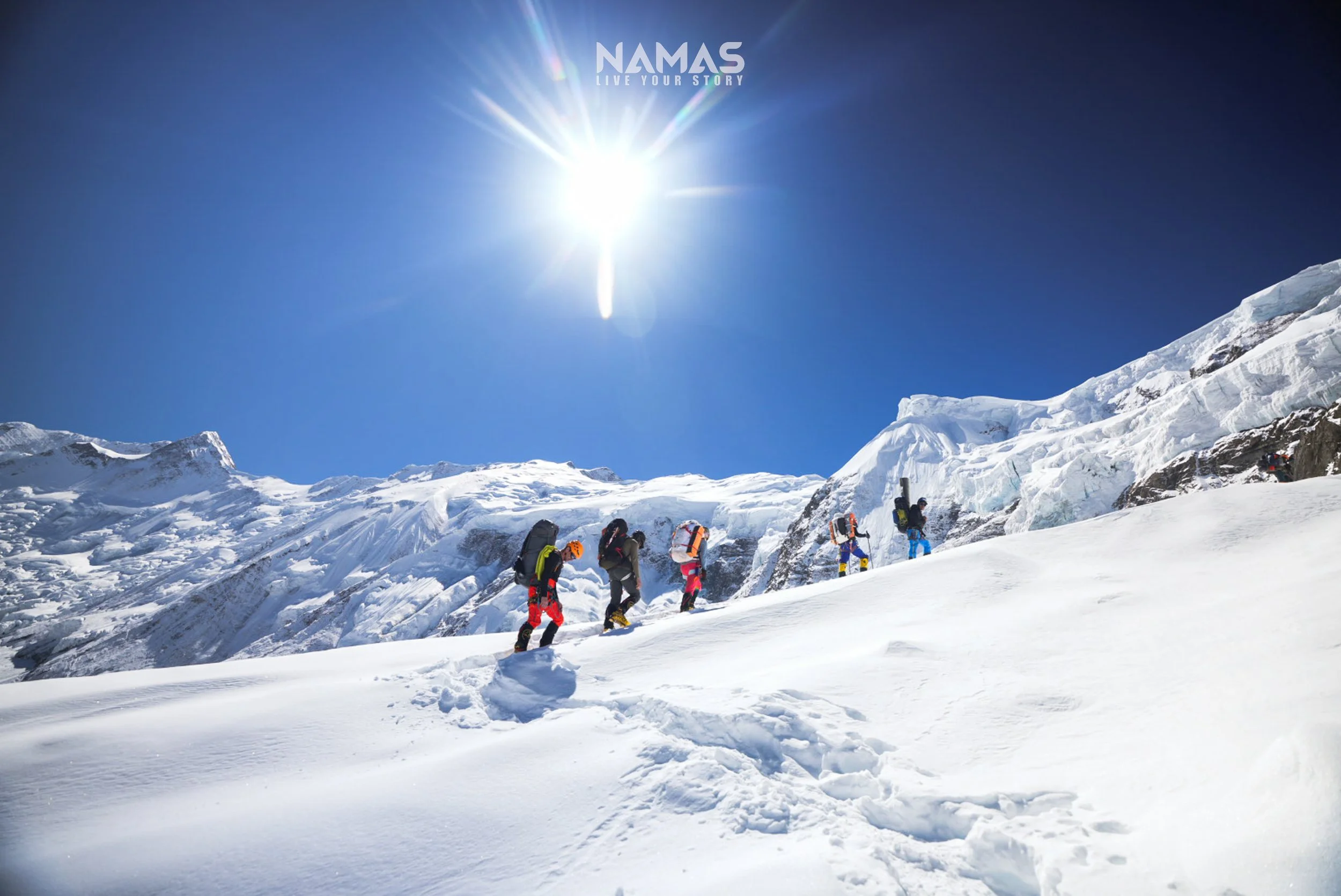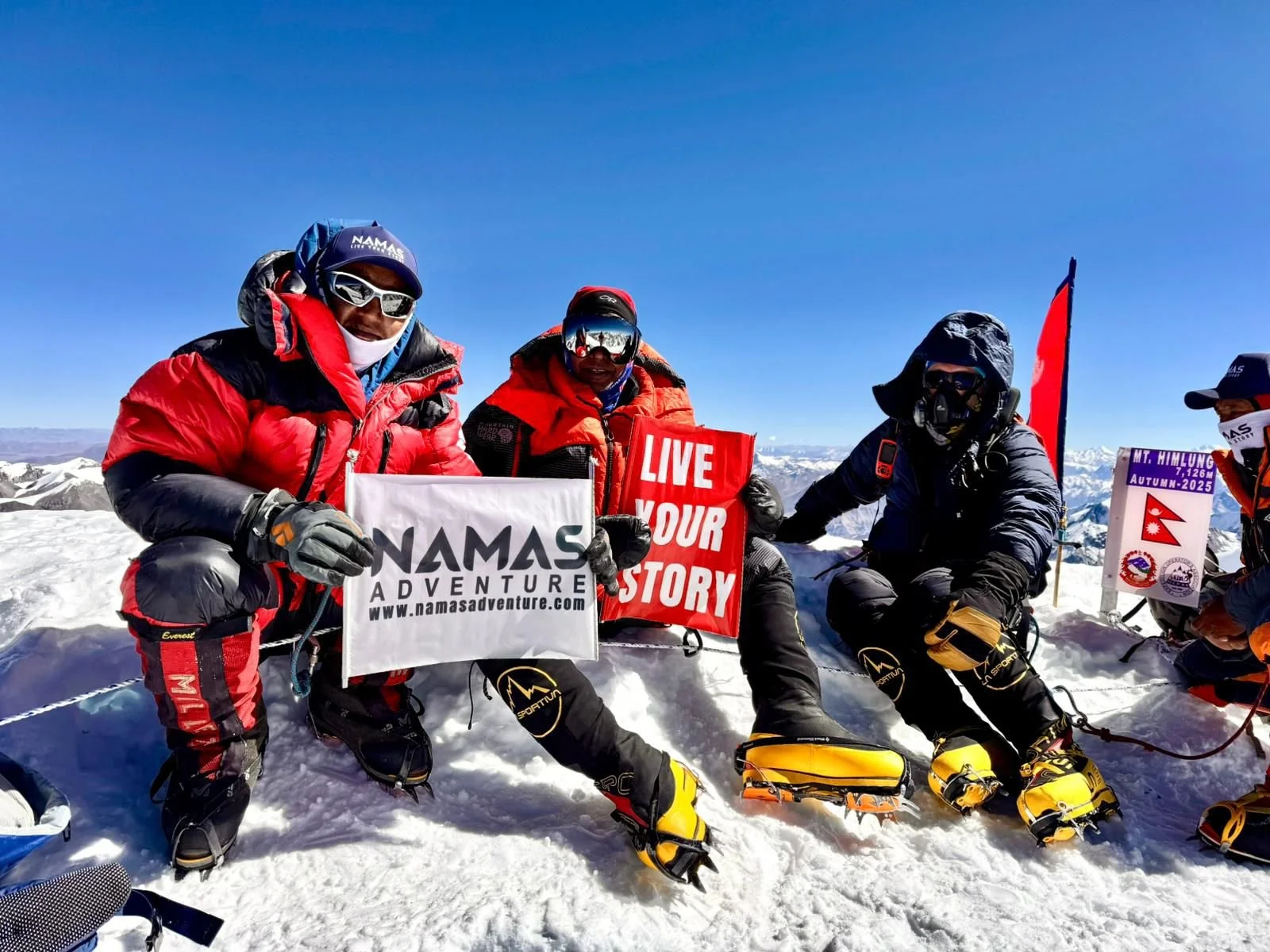Life Above Base Camp: What Every Climber Should Know Before finalizing a 7000m Peak
Life above Base Camp is harsher, colder, and more demanding. But with the right preparation, knowledge, and support, it’s also one of the most rewarding experiences a climber can have. At Namas Adventure, our goal is to help you understand exactly what to expect so you can climb with confidence.
Below, we break down the realities of high-altitude life and the systems that make a 7000m expedition successful
1. Base Camp: Your Recovery & Preparation Zone
Before going higher, you’ll spend a few days at Base Camp resting from the trek in. This is where your body begins adjusting to thinner air and where you perform equipment checks, skill training, meet your personal guides, and settle into a steady daily rhythm.
Base Camp is also the last place where you’ll enjoy relatively comfortable sleeping, bigger meals, and stable communication.
Once the team is fully rested, the acclimatization process begins.
2. Acclimatization Rotations
Rotations are the foundation of any successful 7000M expedition. They gradually expose your body to higher altitude, allowing you to adapt safely.
A Standard Rotation Looks Like:
Base Camp → Camp 1
Sleep one night.
Camp 1 → Camp 2
Sleep one night.
Camp 2 → Base Camp
Descend all the way down to base camp to recover.
Benefits - Each rotation strengthens your body’s ability to handle reduced oxygen levels.
Why Rotations Matter
Increases red blood cell production
Teaches your body to function with low oxygen
Helps you understand your personal altitude response
Allows you to store gear in higher camps to lighten the summit load
Once rotations are complete and weather improves, we prepare for the summit push.
3. Meals, Water, and Sanitation
Life becomes simpler—and much more physical—as you move above Base Camp. Every action you take, whether it’s eating, hydrating, or resting, is aimed at keeping your body strong enough to continue climbing higher.
Meals in High Camps
Food at high altitude needs to be lightweight, easy to prepare, and fuel-efficient. Meals typically include:
Porridge, oats, muesli
Instant noodles and soups
Nuts, biscuits
Freeze-dried meals
Energy bars and gels
Because food options above Base Camp are limited, if you have specific personal snacks or comfort foods, we highly recommend that you bring them from your home country or purchase them in Kathmandu before heading to the mountain. These familiar foods often provide a big mental and physical boost when climbing gets tough.
Water
All water in the higher camps is made by melting and boiling snow or ice. This process takes time and uses a considerable amount of fuel, so staying hydrated requires patience and discipline.
To prevent your water from freezing, you must use insulated bottles or a high-quality thermos. Even at night or during rest periods, keep your water inside your sleeping bag or close to your body to maintain warmth.
Sanitation
There are no toilet facilities in higher camps. All climbers use wag bags, and every bag must be carried back down to Base Camp. Waste is then properly disposed of in the designated Base Camp toilet area.
This system is important for:
Protecting the mountain environment
Preventing health issues
Keeping higher camps clean for all teams and keeping the mountain clean
At Namas Adventure, we strictly follow Leave No Trace principles, ensuring that the mountain remains pristine for future climbers and local communities.
4. Load Distribution: What You Carry vs. What We Carry
You Typically Carry:
Climbing boots, Climbing technical gears
Layers and sleeping bag
Snacks and water
Down suit or summit clothing
Sleeping pad
Personal essentials
If you prefer a lighter load, you can hire an assistant guide to carry your gear all the way up to the summit. Rules are different at Kyrgyzstan - Lenin Peak or Aconcagua expedition, please inquire with our team for more details.
Guides/Sherpas Carry:
Tents
Stoves and fuels
Group meals
Ropes, tools and hardware
Group supplemental oxygen and first aid
Heavy communal gear
During rotations, you can leave items at higher camps, reducing weight for the summit push.
5. Your Climbing Backpack: Why 60L - 70L Is the Ideal Size
A 60-70 liter pack is perfect for carrying:
Sleeping bag
Down suit and layers
Water, personal snacks, and personal items
Technical gear
Goggles, mitts, crampons
Oxygen (if applicable)
Using dry bags inside your pack keeps gear protected from snow and moisture.
6. boots required for 7000m climb
With better technologies, climbing shoes have improved every year. We highly recommend double-layered boots like Kailas Everest 8000M, La Sportiva Olympus Mons Cube, Scarpa 8000 phantom, Millet Everest summit GTX. It is wise to spend on good mountaineering boots, as so with all the gears that we have mentioned in this post above.
For your down suit and summit clothing, please refer to this link: Down Suit & Summit Gear – choosing the right layers is just as important as having the right boots.
Foot Care Tips:
Your feet are crucial for a safe and comfortable climb. Proper care can prevent blisters, frostbite, and discomfort.
1. Break in Your Boots Early
Wear your boots on long hikes or walks before the expedition to soften them and shape them to your feet. This prevents blisters and pressure points at high altitude.
2. Use a Sock System
A liner sock plus a thick summit sock reduces friction, wicks moisture, and provides insulation. Carry extra pairs to stay dry.
3. Account for Swelling
Feet swell at altitude. Choose boots with enough room for thick socks and swelling, or consider sizing up slightly.
4. Test Boots and Crampons
Practice walking and climbing with boots and crampons together before traveling. Proper fit saves discomfort and prevents accidents.
5. Keep Feet Warm and Dry
Warm feet are safe feet. Avoid tight lacing, use foot warmers if needed, and keep socks dry. Overnight, store boots inside your sleeping bag to maintain warmth.
7. How to Communicate on High-Altitude Expeditions
At most Base Camps, you’ll have either satellite phone or internet connections (2024/25 recent developments - Nepal) to stay in touch with family and friends. Base Camp is also equipped with solar panels and generators to charge mobile phones and other electronic devices.
Once the team moves above Base Camp, communication becomes more structured and essential for safety:
Satellite Phone: Your main guide carries a satellite phone, providing a direct line to our expedition office in Kathmandu. This is used for critical updates, including weather changes, logistical needs, or emergencies.
Two-Way Radios: All Sherpas carry radios (walkie-talkies) to maintain constant, real-time communication between camps — from Base Camp to higher camps. This ensures smooth coordination for supply movements, schedule adjustments, and rapid response to sudden weather or safety issues.
8. The Summit Push
After rotations and a few days of rest, the summit push begins—usually timed around the best weather window.
Typical Summit Push Schedule
Base Camp → Camp 1
Camp 1 → Camp 2
Camp 2 → Camp 3 (if the route requires it)
Some routes allow skipping Camp 3.Camp 2 or 3 → Summit → Descend to Camp 2 or Camp 1
Final descent to Base Camp
Why We Leave for the Summit at Midnight
Firmer snow
Lower avalanche risk
Calmer winds
More stable temperatures
Enough daylight for the long descent
What Summit Day Feels Like
It’s a long, slow, intensely focused effort with:
Steep slopes
Rope sections
Extreme cold
Very thin air requiring frequent breathing breaks
Supplemental oxygen is optional for many 7000M peaks, depending on climber preference.
Important note: Most climbers underestimate the descent — yet it’s often the most critical and dangerous part of the entire climb. After days of pushing uphill, your body is tired, your focus drops, and that’s when most accidents happen.
The descent is tedious, demanding, and requires just as much strength, awareness, and discipline as the ascent. You must be as strong coming down as you were going up.
9. Sleeping System
Nights above Base Camp are brutally cold. Your sleeping system must be reliable:
Expedition-grade down sleeping bag
Down suit or warm summit layers
Insulated sleeping pad(s) to block ground cold
10. Hydration, Nutrition & Mental Endurance
Hydration
Staying hydrated is critical at high altitude, as dehydration can worsen fatigue and increase the risk of altitude sickness. Drink regularly throughout the day, even if you don’t feel thirsty.
Nutrition
At altitude, your appetite often decreases, but your body requires high-calorie, easily digestible foods to maintain energy. Focus on:
Soups and instant noodles for warmth and quick energy
Energy bars and gels for on the go nutrition
Nuts, chocolates, and biscuits for concentrated calories
Freeze-dried meals when available
Plan to eat small amounts frequently rather than forcing large meals, as your digestive system slows down in thin air.
Mental Endurance
Life above Base Camp challenges not just the body but the mind. You will face:
Limited sleep due to altitude and cold
Harsh winds and sub-zero temperatures
Slow progress on steep or technical terrain
Long days with continuous physical and mental demands
11. Environmental Responsibility & Safety
Environmental Care
Pack out all trash
Carry down all human waste
Respect the local environment and culture
Safety
Understand altitude sickness symptoms
Weather changes quickly—follow your guide’s decisions
Carry personal medications and essentials
Communicate honestly with guides about how you feel
At Namas Adventure, your safety is always our top priority.
Climbing a 7000m peak is one of the most demanding and rewarding experiences in mountaineering. Life above Base Camp tests your strength, discipline, and mindset — but with the right preparation, guidance, and support system, it becomes a life-changing milestone rather than an overwhelming challenge.
At Namas Adventure, we’ve built our expedition approach around safety, smart acclimatization, experienced Sherpa support, and clear communication from Base Camp to the summit. Whether you aim to gain high-altitude experience, prepare for future 8000m climbs, or push your personal limits, our 7000m expeditions offer the perfect foundation.
Each mountain carries its own character — from technical challenges to less-crowded routes — giving climbers a chance to grow, learn, and experience the raw beauty of the Himalayas and Central Asia.
If your goal is to climb higher, prepare for an 8000m expedition, or take on a major high-altitude challenge, a 7000m climb is the step that transforms you.
When you’re ready to take that step, we’re here to guide you — safely, confidently, and with purpose.
Live Your Story




